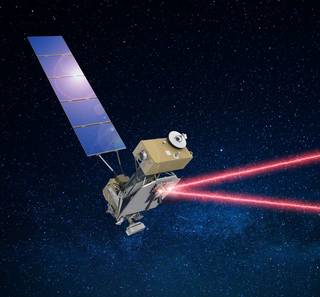
“The goal of the Laser Communications Relay Demonstration project is to prove the utility of bidirectional optical communications relay services between geosynchronous orbit and Earth. The project supports the advanced communications, navigation, and avionics exploration key focus areas. This effort will prove optical communications technology in an operational setting, providing data rates up to 100 times faster than today’s radio frequency-based communication systems. The demonstration will measure and characterize the system performance over a variety of conditions, develop operational procedures, assess applicability for future missions, and provide an on-orbit capability for test and demonstration of standards for optical relay communications. This capability, if successfully demonstrated, could be quickly infused into NASA missions, other Federal agencies, and U.S. satellite manufacturers and operators given the rising demand for bandwidth.[12]
Laser Communications Relay Demonstration will fly as a hosted payload with the U.S. Air Force Space Test Program (STPSat-6). Upon a successful flight demonstration, NASA will provide the communications industry with access to the integrated system to test these new capabilities for commercial applications.” wiki
Dec. 7 Live Broadcast: Atlas V STP-3 – YouTube
https://en.wikipedia.org/wiki/Laser_Communications_Relay_Demonstration

Lasers are the most inefficient invention man has ever made but apparently this is more efficient than radio waves from what I read. Interesting. Also a couple more years of research before any practical application. Space station is going to goof off with it for a while.
True not long ago, but not so much anymore. Electrical to optical conversion efficiency has reached the high 30% range for semiconductor diodes and high power diode pumped fiber optical cutting lasers now, and is now pushing 40%. That’s just a few percent below the best LEDs and better than fluorescent bulbs. Expensive though, and clouds are a problem… I spent a decade in the business between Coherent and nLight. This seems more like the boundary between possible and practical to me.
The big win for optical is “antenna gain”. An optical telescope can make a much narrower beam than a same size antenna. Depending on frequency this can be more than 1000 to 1 beamwidth, which means 1 million to 1 power gain. Lower electrical conversion efficiency doesn’t matter when you have 1 million to 1 gain from the antenna.
The lunar experiment showed the laser beam to be a few dozen miles across, vs geo-synchronous spot beams still being hundreds of miles across. And the available bandwidth for data modulation added another 10-100 in bandwidth gain over radio.
But there are the big (huge?) problems of pointing accuracy, tracking accuracy, and clouds. This satellite is working in the infrared, which helps with clouds and hurts with beam width. Experiments like this deliver answers to whether the engineers have found adequate solutions to the problems, or whether more work is needed.
Cost comparisons are tricky. Optical telescopes are harder to get right than radio antenna, but they are much smaller and lighter than big radio antenna, and telescopes are a well understood technology. Tracking is a big potential cost driver because both the earth end and the satellite end are moving. If all the engineering and manufacturing challenges work out, the expected cost per megabyte will be very low.
My understanding is there was an earlier demo several years ago. It was reportedly successful but on a much smaller scale. In addition to higher data rates NASA is claiming that this will reduce size, weight, and power requirements.
As for clouds, there is some new science out there about cloud-piercing radars. But they operate in the teraWatt range so may only be good for ground stations?
Ooops! That should read “cloud-piercing lasers”.